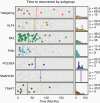Associations of meningioma molecular subgroup and tumor recurrence
- PMID: 33068421
- PMCID: PMC8099468
- DOI: 10.1093/neuonc/noaa226
Associations of meningioma molecular subgroup and tumor recurrence
Abstract
Background: We and others have identified mutually exclusive molecular subgroups of meningiomas; however, the implications of this classification for clinical prognostication remain unclear. Integrated genomic and epigenomic analyses implicate unique oncogenic processes associated with each subgroup, suggesting the potential for divergent clinical courses. The aim of this study was to understand the associated clinical outcomes of each subgroup, as this could optimize treatment for patients.
Methods: We analyzed outcome data for 469 meningiomas of known molecular subgroup, including extent of resection, postoperative radiation, surveillance imaging, and time to recurrence, when applicable. Statistical relationships between outcome variables and subgroup were assessed. Features previously associated with recurrence were further investigated after stratification by subgroup. We used Kaplan-Meier analyses to compare progression-free survival, and identified factors significantly associated with recurrence using Cox proportional hazards modeling.
Results: Meningioma molecular subgroups exhibited divergent clinical courses at 2 years of follow-up, with several aggressive subgroups (NF2, PI3K, HH, tumor necrosis factor receptor-associated factor 7 [TRAF7]) recurring at an average rate of 22 times higher than others (KLF4, POLR2A, SMARCB1). PI3K-activated tumors recurred earlier than other subgroups but had intermediate long-term outcome. Among low-grade tumors, HH and TRAF7 meningiomas exhibited elevated recurrence compared with other subgroups. Recurrence of NF2 tumors was associated with male sex, high grade, and elevated Ki-67. Multivariate analysis identified molecular subgroup as an independent predictor of recurrence, along with grade and previous recurrence.
Conclusion: We describe distinct clinical outcomes and recurrence rates associated with meningioma molecular subgroups. Our findings emphasize the importance of genomic characterization to guide postoperative management decisions for meningiomas.
Keywords: meningioma genomics; molecular subgroups; precision medicine; tumor prognosis.
© The Author(s) 2020. Published by Oxford University Press on behalf of the Society for Neuro-Oncology. All rights reserved. For permissions, please e-mail: journals.permissions@oup.com.
Figures






References
-
- Day SE, Halasz LM. Radiation therapy for WHO grade I meningioma. Chin Clin Oncol. 2017;6(Suppl 1):S4. - PubMed
-
- Louis DN, Perry A, Reifenberger G, et al. . The 2016 World Health Organization classification of tumors of the central nervous system: a summary. Acta Neuropathol. 2016;131(6):803–820. - PubMed
Publication types
MeSH terms
Grants and funding
LinkOut - more resources
Full Text Sources
Miscellaneous

